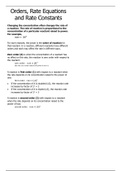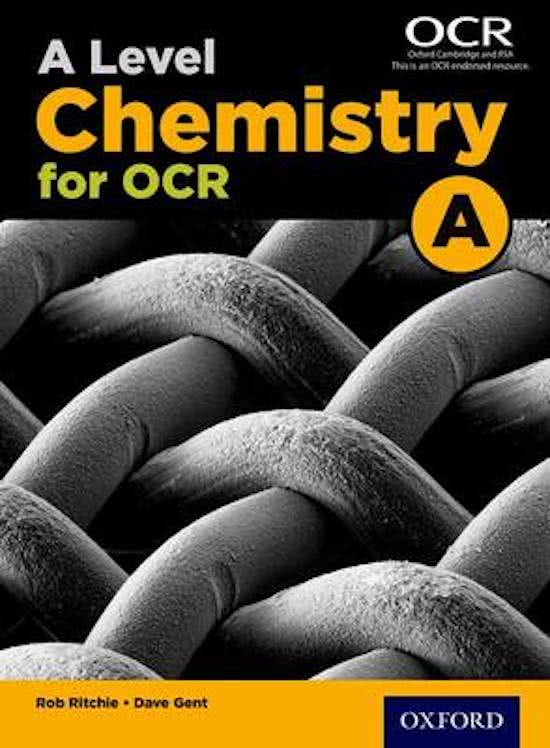Orders, Rate Equations
and Rate Constants
Changing the concentration often changes the rate of
a reaction. The rate of reaction is proportional to the
concentration of a particular reactant raised to power.
For example,
𝒓𝒂𝒕𝒆 ∝ [𝑨]𝒏
For each reactant, the power is the order of reaction for
that reactant. In a reaction, different reactants have different
orders and each may affect the rate in different ways.
Zero order (0) is when the concentration of a reactant has
no effect on the rate, the reaction is zero order with respect to
the reactant:
zero order: 𝑟𝑎𝑡𝑒 ∝ [𝐴]"
side note: any number raised to the power of zero is 1
A reaction is first order (1) with respect to a reactant when
the rate depends on its concentration raised to the power of
one:
first order: 𝑟𝑎𝑡𝑒 ∝ [𝐴]#
• If the concentration of A is doubled (x2), the reaction rate
increases by factor of 21 = 2
• If the concentration of A is tripled (x3), the reaction rate
increases by factor of 31 = 3
A reaction is second order (2) with respect to a reactant
when the rate depends on its concentration raised to the
power of two:
second order: 𝑟𝑎𝑡𝑒 ∝ [𝐴]$
,• If the concentration of A is doubled (x2), the reaction rate
increases by factor of 22 = 4
• If the concentration of A is tripled (x3), the reaction rate
increases by factor of 32 = 9
The rate equation:
order of reaction with respect to A
order of
𝑟𝑎𝑡𝑒 = 𝑘 [𝑨]% [𝑩]& reaction with
rate of reaction
respect to B
concentration of B
rate constant concentration of A
Units of the rate constant:
Ex. overall order: 2. 𝑟𝑎𝑡𝑒 = 𝑘 [𝑨]$ [𝑩]#
'()* %/01%#$ 2 #"
𝑘 = [𝑨]! [𝑩]" = (%/01%#$ )(%/01%#$ ) units = dm3mol-1s-1
overall order = sum of orders with respect to each reactant
so, for the rate equation (above): overall order = 𝑚 + 𝑛
Orders of reaction must be determined experimentally by
monitoring how physical quantity changes over time. Orders
cannot be found directly from the chemical reaction.
When comparing the effect of different concentrations of
reactants on reaction rates, it is important that the rate is
always measured after the same time, ideally as close to the
start of the experiment as possible.
, Conc.–Time Graphs
Continuous monitoring of rates, by continuously taking
measurements during the course of a reaction, means
concentration-time graphs can be plotted.
Two methods for continuous monitoring of reactions – that
produce a gas as one of the products:
• Monitoring by gas collection
• Monitoring by mass loss
Monitoring rate with a colorimeter
A colorimeter measures the intensity of light passing through
a coloured solution – controlled using a filter. The filter is
chosen so that it is complementary colour to the colour being
absorbed in the reaction. Absorbance is recorded, which is
directly linked to the concentration of the solution.
Concentration-time graphs
the gradient of a concentration-time graph is the rate of the
reaction.
Zero order
A zero order reaction
produces a straight line with
a negative gradient;
reaction rate does not
change at all. The value of
the gradient is equal to the
rate constant, k.
First order
A first order reaction
produces a downward curve
with a decreasing gradient over time; therefore, the reaction
gradually slows down. The time for the concentration of the
reactant the reactant to halve is constant, this time is called
the half-life.
, Half-life
Half-life, t1/2, is the time taken for the concentration of a
reactant to decrease by half. A first order relationship can be
confirmed from a concentration-time graph by measuring
successive half-lives. If they are the same, the reaction is first
order with respect to the reactant.
Determination of k for a first order reaction
• Calculating the rate constant from the rate:
The gradient of a tangent to the curve on a concentration-
time graph is calculated giving the rate of reaction. The rate
constant is then calculated by rearranging the rate equation
and substituting in the values for concentration and the
corresponding rate.
• Calculating the rate constant from the half-life
𝑙𝑛2
𝑘=
𝑡!/#
This method is also much more accurate than drawing a
tangent.





